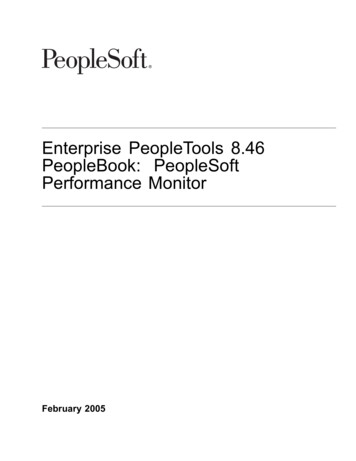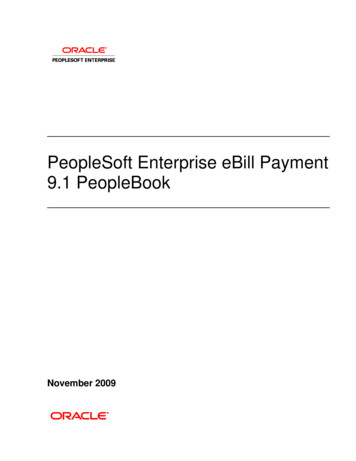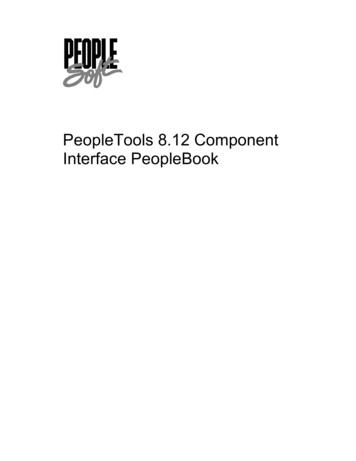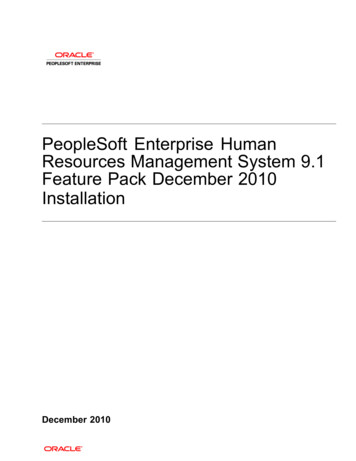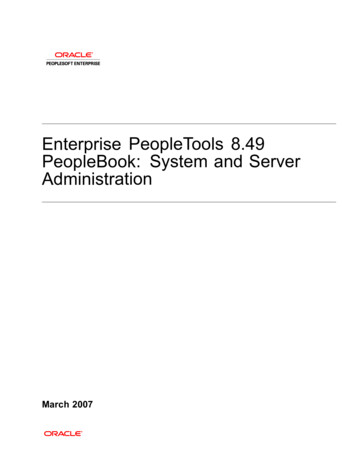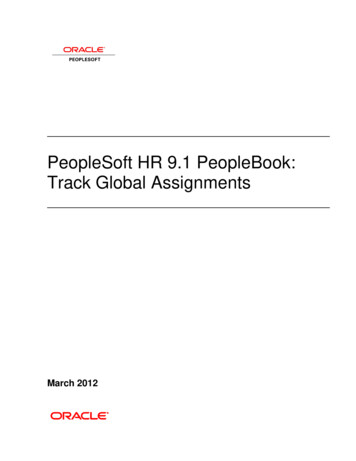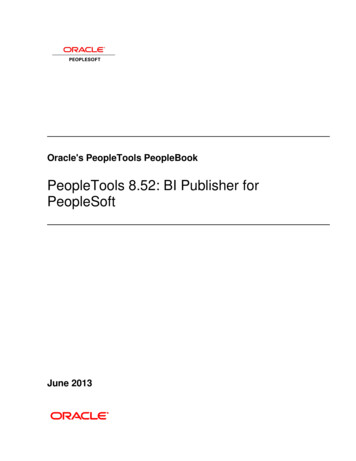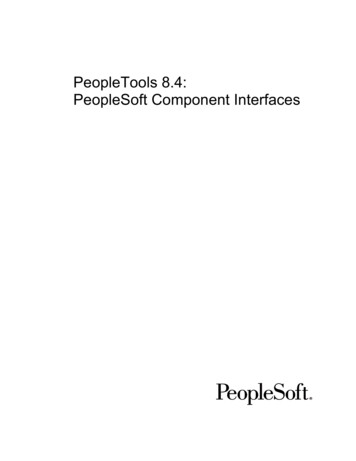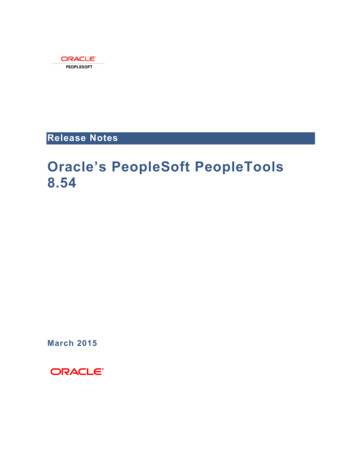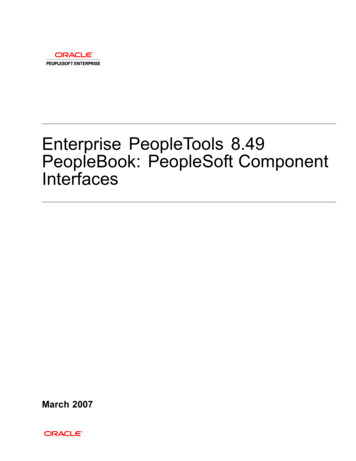
Transcription
Enterprise PeopleTools 8.49PeopleBook: PeopleSoft ComponentInterfacesMarch 2007
Enterprise PeopleTools 8.49 PeopleBook: PeopleSoft Component InterfacesSKU PT849CPI-B 0307Copyright 1988-2007, Oracle. All rights reserved.The Programs (which include both the software and documentation) contain proprietary information; they areprovided under a license agreement containing restrictions on use and disclosure and are also protected by copyright,patent, and other intellectual and industrial property laws. Reverse engineering, disassembly, or decompilation of thePrograms, except to the extent required to obtain interoperability with other independently created software or asspecified by law, is prohibited.The information contained in this document is subject to change without notice. If you find any problems in thedocumentation, please report them to us in writing. This document is not warranted to be error-free. Except as maybe expressly permitted in your license agreement for these Programs, no part of these Programs may be reproduced ortransmitted in any form or by any means, electronic or mechanical, for any purpose.If the Programs are delivered to the United States Government or anyone licensing or using the Programs on behalf ofthe United States Government, the following notice is applicable:U.S. GOVERNMENT RIGHTSPrograms, software, databases, and related documentation and technical data delivered to U.S. Governmentcustomers are “commercial computer software” or “commercial technical data” pursuant to the applicable FederalAcquisition Regulation and agency-specific supplemental regulations. As such, use, duplication, disclosure,modification, and adaptation of the Programs, including documentation and technical data, shall be subject tothe licensing restrictions set forth in the applicable Oracle license agreement, and, to the extent applicable, theadditional rights set forth in FAR 52.227-19, Commercial Computer Software--Restricted Rights (June 1987).Oracle Corporation, 500 Oracle Parkway, Redwood City, CA 94065.The Programs are not intended for use in any nuclear, aviation, mass transit, medical, or other inherently dangerousapplications. It shall be the licensee’s responsibility to take all appropriate fail-safe, backup, redundancy and othermeasures to ensure the safe use of such applications if the Programs are used for such purposes, and we disclaimliability for any damages caused by such use of the Programs.The Programs may provide links to Web sites and access to content, products, and services from third parties.Oracle is not responsible for the availability of, or any content provided on, third-party Web sites. You bear all risksassociated with the use of such content. If you choose to purchase any products or services from a third party, therelationship is directly between you and the third party. Oracle is not responsible for: (a) the quality of third-partyproducts or services; or (b) fulfilling any of the terms of the agreement with the third party, including delivery ofproducts or services and warranty obligations related to purchased products or services. Oracle is not responsible forany loss or damage of any sort that you may incur from dealing with any third party.Oracle, JD Edwards, PeopleSoft, and Siebel are registered trademarks of Oracle Corporation and/or its affiliates.Other names may be trademarks of their respective owners.Open Source DisclosureOracle takes no responsibility for its use or distribution of any open source or shareware software or documentationand disclaims any and all liability or damages resulting from use of said software or documentation. The followingopen source software may be used in Oracle’s PeopleSoft products and the following disclaimers are provided.Apache Software FoundationThis product includes software developed by the Apache Software Foundation (http://www.apache.org/). Copyright 2000-2003. The Apache Software Foundation. All rights reserved. Licensed under the Apache License, Version2.0 (the “License”); you may not use this file except in compliance with the License. You may obtain a copy of theLicense at http://www.apache.org/licenses/LICENSE-2.0.Unless required by applicable law or agreed to in writing, software distributed under the License is distributed on an“AS IS” BASIS, WITHOUT WARRANTIES OR CONDITIONS OF ANY KIND, either express or implied. See theLicense for the specific language governing permissions and limitations under the License.OpenSSLCopyright 1998-2005 The OpenSSL Project. All rights reserved.
This product includes software developed by the OpenSSL Project for use in the OpenSSL Toolkit(http://www.openssl.org/).THIS SOFTWARE IS PROVIDED BY THE OpenSSL PROJECT “AS IS” AND ANY EXPRESSED ORIMPLIED WARRANTIES, INCLUDING, BUT NOT LIMITED TO, THE IMPLIED WARRANTIES OFMERCHANTABILITY AND FITNESS FOR A PARTICULAR PURPOSE ARE DISCLAIMED. IN NO EVENTSHALL THE OpenSSL PROJECT OR ITS CONTRIBUTORS BE LIABLE FOR ANY DIRECT, INDIRECT,INCIDENTAL, SPECIAL, EXEMPLARY, OR CONSEQUENTIAL DAMAGES (INCLUDING, BUT NOTLIMITED TO, PROCUREMENT OF SUBSTITUTE GOODS OR SERVICES; LOSS OF USE, DATA, ORPROFITS; OR BUSINESS INTERRUPTION) HOWEVER CAUSED AND ON ANY THEORY OF LIABILITY,WHETHER IN CONTRACT, STRICT LIABILITY, OR TORT (INCLUDING NEGLIGENCE OR OTHERWISE)ARISING IN ANY WAY OUT OF THE USE OF THIS SOFTWARE, EVEN IF ADVISED OF THE POSSIBILITYOF SUCH DAMAGE.Loki LibraryCopyright 2001 by Andrei Alexandrescu. This code accompanies the book: Alexandrescu, Andrei. “Modern C Design: Generic Programming and Design Patterns Applied”. Copyright 2001 Addison-Wesley. Permission touse, copy, modify, distribute and sell this software for any purpose is hereby granted without fee, provided that theabove copyright notice appear in all copies and that both that copyright notice and this permission notice appear insupporting documentation.Helma ProjectCopyright 1999-2004 Helma Project. All rights reserved. THIS SOFTWARE IS PROVIDED “AS IS”AND ANY EXPRESSED OR IMPLIED WARRANTIES, INCLUDING, BUT NOT LIMITED TO, THEIMPLIED WARRANTIES OF MERCHANTABILITY AND FITNESS FOR A PARTICULAR PURPOSE AREDISCLAIMED. IN NO EVENT SHALL THE HELMA PROJECT OR ITS CONTRIBUTORS BE LIABLE FORANY DIRECT, INDIRECT, INCIDENTAL, SPECIAL, EXEMPLARY, OR CONSEQUENTIAL DAMAGES(INCLUDING, BUT NOT LIMITED TO, PROCUREMENT OF SUBSTITUTE GOODS OR SERVICES;LOSS OF USE, DATA, OR PROFITS; OR BUSINESS INTERRUPTION) HOWEVER CAUSED AND ONANY THEORY OF LIABILITY, WHETHER IN CONTRACT, STRICT LIABILITY, OR TORT (INCLUDINGNEGLIGENCE OR OTHERWISE) ARISING IN ANY WAY OUT OF THE USE OF THIS SOFTWARE, EVEN IFADVISED OF THE POSSIBILITY OF SUCH DAMAGE.Helma includes third party software released under different specific license terms. See the licenses directory in theHelma distribution for a list of these license.SarissaCopyright 2004 Manos Batsis.This library is free software; you can redistribute it and/or modify it under the terms of the GNU Lesser GeneralPublic License as published by the Free Software Foundation; either version 2.1 of the License, or (at your option)any later version.This library is distributed in the hope that it will be useful, but WITHOUT ANY WARRANTY; without even theimplied warranty of MERCHANTABILITY or FITNESS FOR A PARTICULAR PURPOSE. See the GNU LesserGeneral Public License for more details.You should have received a copy of the GNU Lesser General Public License along with this library; if not, write tothe Free Software Foundation, Inc., 59 Temple Place, Suite 330, Boston, MA 02111-1307 USA.ICUICU License - ICU 1.8.1 and later COPYRIGHT AND PERMISSION NOTICE Copyright 1995-2003International Business Machines Corporation and others. All rights reserved.
Permission is hereby granted, free of charge, to any person obtaining a copy of this software and associateddocumentation files (the “Software”), to deal in the Software without restriction, including without limitation therights to use, copy, modify, merge, publish, distribute, and/or sell copies of the Software, and to permit personsto whom the Software is furnished to do so, provided that the above copyright notice(s) and this permissionnotice appear in all copies of the Software and that both the above copyright notice(s) and this permission noticeappear in supporting documentation. THE SOFTWARE IS PROVIDED “AS IS,” WITHOUT WARRANTYOF ANY KIND, EXPRESS OR IMPLIED, INCLUDING BUT NOT LIMITED TO THE WARRANTIES OFMERCHANTABILITY, FITNESS FOR A PARTICULAR PURPOSE AND NONINFRINGEMENT OF THIRDPARTY RIGHTS. IN NO EVENT SHALL THE COPYRIGHT HOLDER OR HOLDERS INCLUDED IN THISNOTICE BE LIABLE FOR ANY CLAIM, OR ANY SPECIAL INDIRECT OR CONSEQUENTIAL DAMAGES,OR ANY DAMAGES WHATSOEVER RESULTING FROM LOSS OF USE, DATA OR PROFITS, WHETHER INAN ACTION OF CONTRACT, NEGLIGENCE OR OTHER TORTIOUS ACTION, ARISING OUT OF OR INCONNECTION WITH THE USE OR PERFORMANCE OF THIS SOFTWARE. Except as contained in this notice,the name of a copyright holder shall not be used in advertising or otherwise to promote the sale, use or other dealingsin this Software without prior written authorization of the copyright holder.All trademarks and registered trademarks mentioned herein are the property of their respective owners.Sun’s JAXB Implementation – JDSDK 1.5 relaxngDatatype.jar 1.0 LicenseCopyright 2001, Thai Open Source Software Center Ltd, Sun Microsystems. All rights reserved.THIS SOFTWARE IS PROVIDED BY THE COPYRIGHT HOLDERS AND CONTRIBUTORS “ASIS” AND ANY EXPRESS OR IMPLIED WARRANTIES, INCLUDING, BUT NOT LIMITED TO, THEIMPLIED WARRANTIES OF MERCHANTABILITY AND FITNESS FOR A PARTICULAR PURPOSEARE DISCLAIMED. IN NO EVENT SHALL THE REGENTS OR CONTRIBUTORS BE LIABLE FORANY DIRECT, INDIRECT, INCIDENTAL, SPECIAL, EXEMPLARY, OR CONSEQUENTIAL DAMAGES(INCLUDING, BUT NOT LIMITED TO, PROCUREMENT OF SUBSTITUTE GOODS OR SERVICES;LOSS OF USE, DATA, OR PROFITS; OR BUSINESS INTERRUPTION) HOWEVER CAUSED AND ONANY THEORY OF LIABILITY, WHETHER IN CONTRACT, STRICT LIABILITY, OR TORT (INCLUDINGNEGLIGENCE OR OTHERWISE) ARISING IN ANY WAY OUT OF THE USE OF THIS SOFTWARE, EVEN IFADVISED OF THE POSSIBILITY OF SUCH DAMAGE.W3C IPR SOFTWARE NOTICECopyright 2000 World Wide Web Consortium, (Massachusetts Institute of Technology, Institut National deRecherche en Informatique et en Automatique, Keio University). All Rights Reserved.Note: The original version of the W3C Software Copyright Notice and License could be found tware-19980720.THIS SOFTWARE AND DOCUMENTATION IS PROVIDED “AS IS,” AND COPYRIGHT HOLDERS MAKENO REPRESENTATIONS OR WARRANTIES, EXPRESS OR IMPLIED, INCLUDING BUT NOT LIMITED TO,WARRANTIES OF MERCHANTABILITY OR FITNESS FOR ANY PARTICULAR PURPOSE OR THAT THEUSE OF THE SOFTWARE OR DOCUMENTATION WILL NOT INFRINGE ANY THIRD PARTY PATENTS,COPYRIGHTS, TRADEMARKS OR OTHER RIGHTS. COPYRIGHT HOLDERS WILL NOT BE LIABLE FORANY DIRECT, INDIRECT, SPECIAL OR CONSEQUENTIAL DAMAGES ARISING OUT OF ANY USE OFTHE SOFTWARE OR DOCUMENTATION.
ContentsGeneral PrefaceAbout This PeopleBook . . . . .xiPeopleSoft Enterprise Application Prerequisites. . . . . . . . . . .xiApplication Fundamentals. . . . . . . . . .xiDocumentation Updates and Printed Documentation. .xiiObtaining Documentation Updates.xiiDownloading and Ordering Printed Documentation.xiiAdditional Resources. . . . . . . . .xiiiTypographical Conventions and Visual Cues. .xivTypographical Conventions.xivVisual Cues. . . . . . . .xvCountry, Region, and Industry Identifiers. . . . . . . . .xvCurrency Codes.xviComments and Suggestions. .xviCommon Elements Used in PeopleBooks. .xviPrefacePeopleSoft Component Interfaces Preface. . . . . . . .xixPeopleSoft Component Interfaces. .xixChapter 1Getting Started with PeopleSoft Component Interfaces. .1Overview. .1Implementing PeopleSoft Component Interfaces. .1Implementing the Excel to Component Interfaces Utility.2Chapter 2Introducing Component Interfaces. .3Understanding Component Interfaces. .3Component Interface Architecture. .3Component Interface Attributes. .4Name.4Copyright 1988-2007, Oracle. All rights reserved.v
mponent Interface Definitions and Views. .5Chapter 3Developing the Component Interface. .9Creating the Component Interface Definition. . .9Creating a New Component Interface.9Criteria for Defaulting Properties. . . . . . . . .11Naming the Component Interface Definition. . . . . . . . .11Associating a Component Interface with a Menu. . . . . . . .12Determining Which Fields to Expose. . . . . . . .13Using Keys. . . . . . . . .13Understanding Keys. . . . . . . .13Adding and Deleting Keys. . . . . . . .15Setting Properties. . . . . . . . .15Standard Properties. . . . . . . .15Creating User-Defined Properties. . . . . . . . .27Deleting User-Defined Properties. . . . . . . .28Renaming User-Defined Properties. . . . . . . .28Creating Reference Properties. . . . . . . .29Making Properties Read-Only. . . . . . . .31Working with Collections. . . . . . . . .31Working with Methods. . . . . . . . .32Working with Session Functions and Methods. . . . . . . .32Standard Methods. . . . . . . .33Collection Methods. . . . . . . .37Enabling and Disabling Standard Methods. . . . . . . .41Creating User-Defined Methods. . . . . . . .42Exporting User-Defined Methods. . . . . . . .44Validating the Component Interface. . . . . . . . .44Setting Security Options. . . . . . . . .45Testing the Component Interface. . . . . . . . .46Searching for a Component Interface to Test. . . . . . . .46Testing the Component Interface. . . . . . . .48Determining ItemByKeys Parameters. . . . . . . .51Understanding Synchronization. . . . . . . . .52viCopyright 1988-2007, Oracle. All rights reserved.
ContentsWriting a Component Interface Program. . . . . . . . . .53Runtime Considerations. . . . . . . . .54General Considerations. . . . . . . .54Scope Conflicts. . . . . . . .54Interactive Mode. . . . . . . .55Chapter 4Programming Component Interfaces in Java. . . . . . . . .57Building APIs in Java. . . . . . . . .57Setting Up the Java Environment. . . . . . . . .58Generating a Java Runtime Code Template. . . . . . . . .58Understanding the Java Template. . . . . . . . .60Chapter 5Programming Component Interfaces in C . . . . . . . . .63Building APIs for C . . . . . . . . .63Setting Up the C Environment. . . . . . . . .63Setting Up a Client Machine to Access a C API. . . . . . . .64Configuring a Compiler for the C Project. . . . . . . .64Generating a C Runtime Code Template. . . . . . . . .65Understanding the C Template. . . . . . . . . .66Chapter 6Programming Component Interfaces in COM. . . . . . . . .71Building APIs for COM. . . . . . . . .71Setting Up the COM Environment. . . . . . . . .72Generating a Visual Basic Runtime Code Template. . . . . . . . .73Understanding the Visual Basic Template. . . . . . . . .74Chapter 7Using the Component Interface Software Development Kit. . . . . . . . .77Understanding the Component Interface SDK. . . . . . . . .77Component Interface SDK Samples. . . . . . . .77Setting SDK Prerequisites. . . . . . . . .77Using the SDK BUS EXPENSES Test Page. . . . . . . . .78Testing the SDK BUS EXP. . . . . . . . .78Copyright 1988-2007, Oracle. All rights reserved.vii
ContentsUsing the SDK Java Sample. . . . . . . . .79Running the Java Sample. . . . . . . . .79Understanding the Java Sample Code. . . . . . . .79Using the SDK C Sample. . . . . . . . .81Building the C Sample. . . . . . . .82Running the SDK C Sample. . . . . . . .82Understanding the C Sample Code. . . . . . . .82Using the SDK COM Excel Sample. . . . . . . . .84Running the COM Excel Sample. . . . . . . .84Understanding the COM Excel Sample Code. . . . . . . .85Using the SDK COM ASP Sample. . . . . . . . .86Running the COM ASP Sample. . . . . . . .86Understanding the COM ASP Sample Code. . . . . . . .87Chapter 8Programming Component Interfaces in PeopleCode. . . . . . . . .93Understanding PeopleCode Behavior and Limitations. . . . . . . . .93PeopleCode Event and Function Behavior. . . . . . . .93CopyRowset Language Considerations. . . . . . . .94Limitations of Client-Only PeopleCode. . . . . . . .94Generating a PeopleCode Template. . . . . . . . .95Understanding the PeopleCode Template. . . . . . . . .96Chapter 9Using the Excel to Component Interface Utility. . . . . . . . .99Understanding the Excel to Component Interface Utility. . . . . . . . . .99Building a Component Interface for the Excel to Component Interface Utility.100Getting Started with the Excel to Component Interface Utility.102Viewing the Coversheet.103Setting Up Connection Information. .103Entering Connection Information.103Connecting to the Database to Create a Template and Submit Data.106Creating a Template. .107Understanding the Template Actions Toolbar.108Entering Data into the Template.110Template Wrapping. . . . . . .111Entering Data on the Data Input Sheet. . . . . . . .111Using the Data Input Sheet. . . . . . .111viiiCopyright 1988-2007, Oracle. All rights reserved.
ContentsViewing the Staged Data. .113Correcting and Resubmitting Data.114Creating a SOAP/XML Request. .115Request Format.115Sample Create Request.115Sample Get Request.116Sample Update Request.116Sample Updatedata Request.116Sending the Request. .117Receiving a Response. .117Viewing a Response if a Row Already Exists. .117Viewing a Sample Get Request and Response.118Diagnosing and Resolving Errors. .119Viewing Log Files.119Resolving Error Messages for Client Environments.119Glossary of PeopleSoft Enterprise Terms.121Index .147Copyright 1988-2007, Oracle. All rights reserved.ix
ContentsxCopyright 1988-2007, Oracle. All rights reserved.
About This PeopleBookPeopleSoft Enterprise PeopleBooks provide you with the information that you need to implement and use PeopleSoftEnterprise applications from Oracle.This preface discusses: PeopleSoft Enterprise application prerequisites. Application fundamentals. Documentation updates and printed documentation. Additional resources. Typographical conventions and visual cues. Comments and suggestions. Common elements in PeopleBooks.Note. PeopleBooks document only elements, such as fields and check boxes, that require additional explanation. If anelement is not documented with the process or task in which it is used, then either it requires no additional explanationor it is documented with common elements for the section, chapter, PeopleBook, or product line. Elements that arecommon to all PeopleSoft Enterprise applications are defined in this preface.PeopleSoft Enterprise Application PrerequisitesTo benefit fully from the information that is covered in these books, you should have a basic understandingof how to use PeopleSoft Enterprise applications.You might also want to complete at least one introductory training course, if applicable.You should be familiar with navigating the system and adding, updating, and deleting information by usingPeopleSoft Enterprise menus, pages, or windows. You should also be comfortable using the World Wide Weband the Microsoft Windows or Windows NT graphical user interface.These books do not review navigation and other basics. They present the information that you need to use thesystem and implement your PeopleSoft Enterprise applications most effectively.Application FundamentalsEach application PeopleBook provides implementation and processing i
About This PeopleBook PeopleSoft Enterprise PeopleBooks provide you with the information that you need to implement and use PeopleSoft Enterprise applications from Oracle.
